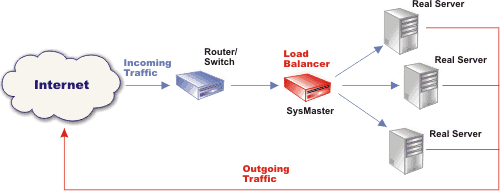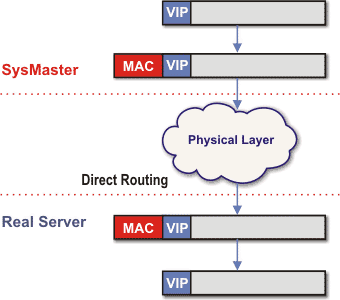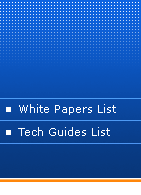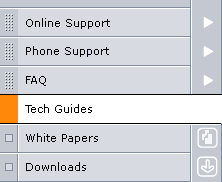Direct-Path Routing is SysMaster's optimal routing
technique. It takes advantage of the asymmetrical inbound and
outbound Internet traffic. The client to server traffic, flows
through SysMaster to the real server. The outbound traffic, which
typically consumes more bandwidth, because it contains the requested
information, goes directly to the client. By avoiding the SysMaster,
Direct-Path Routing provides greater outbound performance and
latency improvement.
When network solutions use Direct-Path Routing,
SysMaster and all the real servers that provide a given virtual
service have an interface configured with the Virtual IP, but
only the SysMaster interface is configured to be accessible from
the Internet. This way only SysMaster receives the incoming packets
and re-routes them to the most available real server. As the real
server has an interface with the same IP address, it accepts the
packet and processes it. In order for Direct Path Routing to work,
SysMaster and the real servers must have a direct physical connection.

When a client sends a request to a service managed by SysMaster,
the request packet arrives at SysMaster. The device checks the
destination IP and port number of the packet and if they are recognized
as the address of one of SysMaster's services, a real server that
will process this request is assigned according to the configured
loadbalancing technique. SysMaster adds a record for this new
connection into its hash table and directly forwards the packet
to the chosen server. All subsequent packets for this connection
will be sent to the same real server as long as the connection
record exists in the hash table. When the server receives the
packet, it finds that there is an interface that can take the
packet, so the server processes the request. The result of the
request is sent directly to the client. When the connection terminates
or expires, its record is removed from the hash table.
How it works?
Let us take a closer look at the Direct Path
Routing technique:

The real servers in a cluster using the Direct
Path routing techniques have at least two IP addresses.
The first is the IP address they use to connect
to the network (RIP) and the second is the IP address of the virtual
service (VIP) they provide. SysMaster identifies the real servers
by their RIP addresses. When SysMaster chooses a real server for
a connection, it asks for the MAC address of the server using
its RIP address. Then the packet is sent to that MAC address without
any changes. When the packet reaches the real server, the service
listening on the VIP address recognizes the packet and processes
it. The reply is sent directly to the client bypassing the loadbalancer.
Increased Performance and Speed
Using this method, SysMaster can process much
more traffic compared to NAT. SysMaster simply changes the destination
MAC address of the data packets and retransmits them on the local
network. That is why the SysMaster device and the real servers
should be connected to one uninterrupted LAN segment.
Another reason for the increased potential of
network solutions using the Direct Path Routing technique is the
SysMaster processes only the in-bound traffic. The response packets
are sent directly to the users and can follow separate network
routes bypassing the loadbalancing device. This increases considerably
the scalability SysMaster implementations using Direct Path Routing
allowing over 100 real servers to be managed by only one device.





